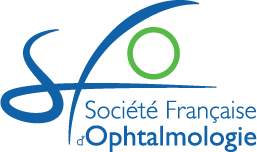To present a case of “sand of the sahara” description on slit lamp, 12 years after LASIK refractive surgery.
Name
Grains de sel: kératite lamellaire diffuse ou kératite herpétique?
But
Observation
A 37 year old male presented to the emergency room for pain, redness, photophobia, and blurry vision in the right eye since 5 days. He had uneventful bilateral LASIK 12 years ago for 4.50 degrees of myopia and denies any recent eye trauma. He only notes labial herpes a week ago. He used tobramycin drops with no improvement.
Cas clinique
His best-corrected visual acuity (BCVA) OD at initial presentation was 5/10 and 10/10 OS without correction. Intraocular pressure was 18 mmHg in OD. Slit-lamp examination revealed corneal haze and diffuse infiltrates under the flap giving the impression of “sand in the sahara”, along with conjunctival injection in all quadrants. No fluorescein corneal staining was seen, normal flap borders, anterior chamber was quiet, and no keratic precipitates were noted. He had normal corneal sensitivity on cotton tip applicator comparative test. Corneal topography revealed symmetric K readings in both eyes. Corneal OCT showed a pachymetry of 508um in the right eye with hypereflectivity of the interface in comparison to 477um in OS. OQAS testing revealed a high OSI of 3.2 in OD compared with 0.8 OS indicating luminous diffusion. Conjunctival swab analysis was not contributive and herpetic serology (IgG) was positive. Patient was prescribed Valaciclovir 500 mg per os, 2 pills 3 times per day with lubricants. HRT revealed rarefication and shortening of corneal nerves along with higher number of dendritic cells indicating an important inflammatory reaction. After 1 week, the patient notes significant improvement of symptoms and vision. He has 10/10 vision without correction in OD. On slit-lamp examination, major decrease of the infiltrates under the flap and the redness was documented.
Discussion
The case was perplexing since it was not clear whether it is a late onset DLK or a herpetic stromal keratitis especially that treatment modalities are totally different and critical. DLK is a rare (<3%) and early (<1 week) complication after LASIK treated favorably with steroids. However, several cases have been described many years postoperatively. DLK may occur beyond the acute postoperative period for months or years due to minimal surface disruption, with or without trauma, dry eyes, and recurrent erosions. Post-LASIK HSV keratitis has been reported in patients with and without a history of herpetic disease so unknown history should not preclude a diagnosis of HSV keratitis. Patients with noninfectious keratitis generally had better visual outcomes than those with infectious etiologies. Hence, we used the therapeutic test for diagnosis and treated HSV with vigilant evolution follow-up before adding any steroids.
Conclusion
Late onset DLK is kept in mind when a “sand of the sahara” syndrome appears delayed after LASIK surgery; however, infectious stromal keratitis such as herpes must be ruled out due to its worse prognosis and requirement of adapted treatment.
